Fixing a Drip Coffee Maker
It's time to fix the leak if water is flowing out of the safety valve of your drip coffee maker. You're likely to be able fix it.
We will also explore how to maintain a coffee maker and learn different ways to make great coffee using a drip coffee machine.
1. Carafe Leaks
Drip coffee is made by pouring hot water over ground coffee beans and permitting the coffee to soak through while being collected in an vessel such as a pot or carafe. It can be made in different ways with various terms being used for the coffee brewed, based on the method used and the equipment being employed. Common methods include pour-over, French drip, and automatic drip.
Using a drip coffee maker can be an ideal way to get your morning caffeine fix without waiting for a cup of tea at a cafe or for it to brew at the office. The ease of these machines can be a problem when they malfunction. One of the most common problems is that the coffee maker drips when you pour. This can be a problem and make your coffee messy, but it could also cause burns to your hands or other surfaces.
The reason the coffee maker might leak when you try to pour is due to how it is positioned. The spout of a carafe is usually located on the back of the pot, close to the water reservoir. This is due to the fact that there is not enough room in the front of the container for a deep, easy-to-pour spout.
Liquids generally follow the path of least resistance, so when it is flowing liquids they'll follow where the lower pressure is. This is the reason why older drip coffee makers drip when you try pouring.
This problem can be solved quickly. Instead of placing the spout at the back of the carafe move it forward so that you are able to reach it with your hand. This will resolve your dribbling problem and will save you the hassle of cleaning your counters each morning.
Another factor that could be causing the dribbling could be the amount of coffee you pour into the carafe. Two tablespoons of coffee per six ounces water is the recommended ratio. However, the density of your grounds will vary, and you might have to adjust the ratio. A kitchen scale is useful to monitor the ratios between coffee and water and to prevent over or under-extraction.
2. Spout Leaks
If you've ever looked at drip coffee makers that are budget-friendly, you'll notice that they come in a wide range of sizes and shapes. Some come with thermal carafes, others don't; some dispense water with tight spout rings while others make use of large ones.
The small valve at the end of the hose can influence the way that the machines disperse water. This valve can become clogged by gunk, causing leaks from the spout. It's simple to repair. Unplug the pot and pour the water into the sink. Remove the valve and clean it.
3. Safety Valve Leaks
Bialetti pots are said to function perfectly, no matter if you're sleeping or heading to the kitchen to flip the magic switch. If you don't notice the murmur or gurgling sound perhaps it's the time to look into.
In the bottom of the bucket, there's an opening and a white tube that leads into it. During the boiling process, the tube carries the boiling water to the coffee pot's drip area. The tube is equipped with a single flow valve that allows cold water to return to the bucket, but causes the bubbles that rise from boiling water to rise in the coffee pot.

If you're seeing steam or pressure constantly being released from your coffee maker through the safety valve there's a possibility that it's blocked and requires servicing or replacement. Place a bucket underneath the safety valve pipe, and then push the lever up several times. (Use gloves as the water is hot). If this doesn't work, it's the right time to consult a professional. This is a long-lasting task since the valve has to be removed and disassembled.
4. Filter Leaks
The reservoir and filter is the core of every drip coffee maker. The reservoir and filter are the heart of every drip coffee maker. It is essential to adhere to the correct water usage guidelines, along with cleaning and maintenance procedures throughout the brewing process. This will ensure that your coffee maker continues to perform at its peak.
When you turn on your coffee pot then the water in the reservoir is heated by the heating element with resistivity and the heat is radiated through a white tube that leads upwards from beneath the reservoir base. drip coffee brewer flows over the ground coffee and begins to absorb flavors from the coffee grounds. As the hot water flows over the coffee grounds, it picks up coffee oils that are released during roasting. These oils give coffee it's distinctive flavor and aroma.
Wet coffee grounds that sit for too long could lead to mold growth. To avoid this keep the grounds in a way that allows them to dry quicker (e.g. hanging, away from the coffee machine, propped up for air flow, etc. ).
If the coffee grounds aren't the right size for your drip coffee maker, they can block the water or cause overflows. This is why it is recommended to use a single, appropriately-sized paper or reusable filter for your drip coffee maker. It is also recommended to play around with the brew duration to find out which setting gives you the best taste.
For optimal performance, regular cleaning and descaling is also necessary. To remove mineral buildup be sure to follow the manufacturer's guidelines on how to clean and decal your machine. Also, try to use filtering or bottled water instead of tap water, as it will contribute to better tasting coffee.
